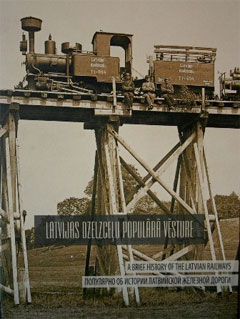
For the 90th anniversary of railroading in Latvia, the Latvian Railway History Museum last year released a DVD, Latvijas dzelzceļu populārā vēsture, containing six short films relating to trains in the country.
The railway museum, owned by Latvijas dzelzceļš (Lavian Railway), also published a coffee table book, in Latvian and English, on the history of the railway, and a photo album entitled Dzelzceļš Rīgā un pieskārieni dvēselei (The Railway in Rīga – Soul-touching Reminiscences).
The DVD, just under an hour in total length, collects some intriguing and fascinating, though brief, glimpses of the history of trains in Latvia.
By far the most interesting film on the collection is “Mazbānītis de facto,” which is a documentary on the history of the narrow gauge countryside rails built in Latvia during World War I. Most all of these rails are gone today, but a particularly nice touch in the documentary is to provide historical pictures of where the stations used to be situated, as well as what stands there today (some station houses are still in place, though the rails have long been replaced by roads).
Also interesting is “Kādas lokomotīves stāsts,” which is a five-minute short on the restoration process of the ML 657 locomotive in Ventspils, and its journey to the Railway Museum in Rīga.
A 10-minute film simply called “Mazbānītis,” made by Ērmanis Rodis in 1985, presents a brief journey with a narrow gauge locomotive that is in his collection.
Additionally, there is “Sapņu ekspresis,” a flight of fancy in the imagination of a young child who sees himself as a conductor, engineer and as the station head. There is also a music video, “Vilciens nāk!,” set to the tune of “Lokomotīve jūras krastā” by Latvian electronic music pioneers Dzeltenie pastnieki. The collection is rounded out by “Muzeja nakts,” a 2-minute glimpse of the yearly event Museum Night, when most every museum in Latvia can be visited for free and stays open late, and usually provides some sort of unique activity or presentation for that night only.
All the features are in Latvian, but all selections feature subtitles in English and Russian. The DVD is also multi-region, so it can be played on DVD players worldwide.
The DVD is a fun watch, but is really rather brief. I would have been interested to see a more in-depth documentary on the whole of Latvian Railway, but I suppose this DVD is merely meant as a complement to the book, which offers a very thorough history of the Latvian rail system, with many pictures and historical notes on most every station that once was in the system. Though considering Latvia’s turbulent past there are still many untold stories in the history of the railway, this DVD provided a charming, yet short, overview of trains in Latvia.
Details
Latvijas dzelzceļu populārå vēsture
Latvijas dzelzceļa vēstures muzejs
Rīga: Latvijas dzelzceļa vēstures muzejs, 2009
© 1995-2024 Latvians Online
Please contact us for editorial queries, or for permission to republish material. Disclaimer: The content of Web sites to which Latvians Online provides links does not necessarily reflect the opinion of Latvians Online, its staff or its sponsors.





How do I get a copy of the book and DVD? Do I need to wait until I get to Latvia in the Spring?
Thank you – it was great to hear that a book will be available on LV’s railways.
Like Anja, I would like to know the prices, availability, and source for book and DVD.
Thanks for this information and review. I’m currently recalling what the Latvian railroad system was like in the years that I lived there (1982-1999). Not bad, but a lot was destroyed in the war and by Soviet neglect. The mazbanītis story is especially poignant as my mother remembers her father working on one in the days of the first republic.